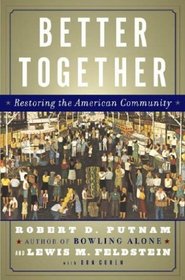Very useful, perhaps a how-to manual given foundation funding. Chapter Four. The Dudley Street Neighborhood Initiative: Grass Roots in the City.
This is about a Roxbury neighborhood that pulled itself together when in a steep decline by deciding what was needed, getting some advice, working hard, and pressing the Mayor of Boston for some support. It is a very mixed area, starting as an Irish neighborhood early in the 20th C. and today has new housing built on wasteland where the building had been burnt down in its worst days. There are continuing needs to be met by having new people participate (some of those obtaining new housing don't realize they will not be able to profit very much from any general increase in the general real estate market).
The catalyst here is the Riley Foundation staff that adopted the neighborhood and acqquiesced when the locals wanted a voice and seats on the development board. While residents are often on the lookout for one ethnic group or another being favored, this model has worked very well to quell such notions. The locals elected their first board members in 1985 and the Riley Foundation ponied up $70,000 in seed money, allowing a professional organizer to be hired.
They divided the locality into a core area for their greatest effort and a secondary portion of the neighborhood that was in relatively decent shape. Eminent domain was sold to the residents as the way to redevelop a 60 acre area in the center that was half owned by the city and half by 181 other folks: the land would be used FOR the local residents. "The concept of a semiautonomous urban village guides development of the triangle and the five-hundred-acre core area of which it is a part (88)."
The authors describe the DSNI board operations and the community center (in what was once a Settlement House). [See Peter Medoff and Holly Sklar, Street of Hope, Boston: South End Press, 1994, LAPL none, but in several other local libraries.] The activist residents are creating a new community, as they want their community to be. "The emphasis on finding a concept that resonates with different parts of the community isone example of the attention to language and the culture it embodies that has been part of DSNI's inclusivist strategy from the beginning (89)." Flyers and newsletters are in three languages and translators attend meetings. The food project (urban garden) they started on two acres helped create community. Board members take care to be in close contact with their constituencies as they discuss old and new initiatives and vote to defeat or ratify Sustainable Development Corporation proposals. There immediate neighborhood is doing so well that they are taking on a troubled adjacent area, although there are sure to be challenges in melding those people into their community's way of doing things. Regarding the careful steps taken to build consensus, the Vine Street Community Center is offered as an example. The chapter closes by considering the challenges of maintaining the high degree of activism they've achieved.
This is about a Roxbury neighborhood that pulled itself together when in a steep decline by deciding what was needed, getting some advice, working hard, and pressing the Mayor of Boston for some support. It is a very mixed area, starting as an Irish neighborhood early in the 20th C. and today has new housing built on wasteland where the building had been burnt down in its worst days. There are continuing needs to be met by having new people participate (some of those obtaining new housing don't realize they will not be able to profit very much from any general increase in the general real estate market).
The catalyst here is the Riley Foundation staff that adopted the neighborhood and acqquiesced when the locals wanted a voice and seats on the development board. While residents are often on the lookout for one ethnic group or another being favored, this model has worked very well to quell such notions. The locals elected their first board members in 1985 and the Riley Foundation ponied up $70,000 in seed money, allowing a professional organizer to be hired.
They divided the locality into a core area for their greatest effort and a secondary portion of the neighborhood that was in relatively decent shape. Eminent domain was sold to the residents as the way to redevelop a 60 acre area in the center that was half owned by the city and half by 181 other folks: the land would be used FOR the local residents. "The concept of a semiautonomous urban village guides development of the triangle and the five-hundred-acre core area of which it is a part (88)."
The authors describe the DSNI board operations and the community center (in what was once a Settlement House). [See Peter Medoff and Holly Sklar, Street of Hope, Boston: South End Press, 1994, LAPL none, but in several other local libraries.] The activist residents are creating a new community, as they want their community to be. "The emphasis on finding a concept that resonates with different parts of the community isone example of the attention to language and the culture it embodies that has been part of DSNI's inclusivist strategy from the beginning (89)." Flyers and newsletters are in three languages and translators attend meetings. The food project (urban garden) they started on two acres helped create community. Board members take care to be in close contact with their constituencies as they discuss old and new initiatives and vote to defeat or ratify Sustainable Development Corporation proposals. There immediate neighborhood is doing so well that they are taking on a troubled adjacent area, although there are sure to be challenges in melding those people into their community's way of doing things. Regarding the careful steps taken to build consensus, the Vine Street Community Center is offered as an example. The chapter closes by considering the challenges of maintaining the high degree of activism they've achieved.




